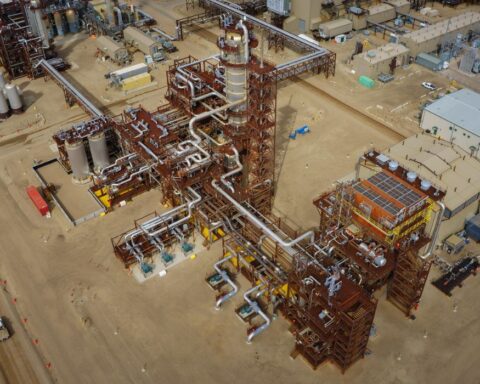A stark choice between climate stability and global devastation is the constant drumbeat from a landmark report released today by the Intergovernmental Panel on Climate Change (IPCC).
“The choices and actions implemented in this decade will have impacts now and for thousands of years,” the UN agency states in its Sixth Assessment Report, a final synthesis that brings together six in-depth science and policy reports dating back to October, 2018.
“There is a rapidly closing window of opportunity to secure a liveable and sustainable future for all,” the IPCC adds. The science shows roughly half the world’s population likely to be exposed to the impacts of climate change, and once-in-a-century climate disasters on track to become annual events.
Already, “widespread and rapid changes in the atmosphere, ocean, cryosphere, and biosphere have occurred,” the report says. “Human-caused climate change is already affecting many weather and climate extremes in every region across the globe. This has led to widespread adverse impacts and related losses and damages to nature and people,” with disproportionate impacts for the “vulnerable communities who have historically contributed the least to current climate change.”
Those findings underscore the need—and spotlight the opportunity—to get climate change and its impacts under control.
“Deep, rapid, and sustained mitigation and accelerated implementation of adaptation actions in this decade would reduce projected losses and damages for humans and ecosystems,” the report says. Delaying those actions “would lock in high-emissions infrastructure, raise risks of stranded assets and cost escalation, reduce feasibility, and increase losses and damages.”
But some meeting participants warned that those delays are baked into the process by some of the key assumptions in the IPCC’s modelling.
“An immediate, rapid, and equitable fossil fuel phaseout is the cornerstone of any strategy to avoid catastrophic levels of global warming,” said Lili Fuhr, deputy director of the climate and energy program at the Geneva-based Centre for International Environmental Law. “Yet the negotiations this past week highlighted the clash between the latest climate science and the mainstream economic models that perpetuate a business-as-usual approach.”
This morning’s report shows how to prevent irreversible harm by scaling up proven climate solutions that are available now, Fuhr added, beginning with replacing fossil fuels with renewable energy, boosting energy efficiency, and reducing energy and resource use. “Building our mitigation strategies on models that instead lock in inequitable growth and conveniently assume away the risks of techno-fixes like carbon capture and storage and carbon dioxide removal ignores that clarion message and increases the likelihood of overshoot.”
We know what to do
The IPCC released its 37-page Summary for Policymakers Monday after a marathon negotiating session in Interlaken, Switzerland ran a day beyond its scheduled close. “You cannot imagine the euphoria that the IPCC synthesis report is pre-approved in the longest plenary ever!” tweeted working group vice-chair Diana Urge-Vorsatz, professor of environmental studies and policy at Central European University. “After 46 hours with a total of three hours of sleep…”
Negotiations bogged down over emissions targets and financing to vulnerable nations, The Associated Press writes.
“The report by hundreds of the world’s top scientists was supposed to be approved by government delegations Friday,” the news agency says. “The deadline was repeatedly extended as officials from big nations such as China, Brazil, Saudi Arabia, as well as the United Nations and the European Union haggled through the weekend over the wording of key phrases in the text.”
The summary combines the utter urgency of the climate crisis with the message that humanity has all the knowledge and tools it needs to drastically reduce greenhouse gas emissions and deliver the financing to help affected regions, countries, and communities respond. Civil society representatives attending the talks said there was no disagreement on 1.5°C as a “survival target” for average global warming, and the meeting recognized that the most technically achievable decarbonization options are also the most economically feasible.
“Several mitigation options, notably solar energy, wind energy, electrification of urban systems, urban green infrastructure, energy efficiency, demand-side management, improved forest and crop/grassland management, and reduced food waste and loss, are technically viable, are becoming increasingly cost effective, and are generally supported by the public,” the Summary for Policymakers states. Between 2010 and 2019, the cost of wind turbines, solar panels, and lithium ion batteries fell 55%, 85%, and 85%, respectively, while solar deployment grew more than tenfold and electric vehicle use increased more than 100-fold.
“What’s missing is political will,” Stephan Singer, senior science and energy advisor at Climate Action Network-International, told a media briefing Sunday. “And that’s a very good message.”
Time to scale up solutions, investment
But with global climate emissions estimated at about 59 billion tonnes in 2019 — 12% higher than in 2010, and 54% higher than in 1990 — the carbon reduction options spotlighted in the report have to scale up, drastically and quickly. In the short term, every region of the world faces “increasing, multiple risks to ecosystems and humans,” including heat-related death and disease, physical and mental health risks, flooding in coastal and low-lying regions, biodiversity loss, food and water scarcity, and more.
“Every increment of global warming will intensify multiple and concurrent hazards,” the IPCC warns. “With further warming, climate change risks will become increasingly complex and more difficult to manage. Multiple climatic and non-climatic risk drivers will interact, resulting in compounding overall risk and risks cascading across sectors and regions.”
But there’s still time to take action if countries pick the right decarbonization options and scale up fast. “Deep, rapid, and sustained reductions in greenhouse gas emissions would lead to a discernible slowdown in global warming within around two decades, and also to discernible changes in atmospheric composition within a few years,” the IPCC writes.
A chart toward the end of the synthesis report shows how important it is to get those choices right. In energy supply, solar and wind deliver by far the highest net emission reductions through 2030 at the lowest cost. Carbon capture and storage (CCS) delivers one-tenth the benefit at far higher cost. Nuclear, geothermal, hydropower, and electricity from biomass do little better.
In land, water, and food systems, the top options are to reduce the loss of natural ecosystems, followed by carbon farming and ecosystem restoration. The IPCC says reducing food loss and food waste has the least impact among a list of strategies. And in settlements and infrastructure, fuel-efficient vehicles, efficient lighting and appliances, transit, biking, efficient shipping and aviation, and avoiding demand for energy services show up as the least expensive options. Efficient buildings are more costly, but can deliver somewhat higher emission reductions in this decade.
The report points to synergies between actions to reduce carbon emissions and adapt to climate impacts, and between climate action and broader sustainable development goals.
“Rapid and far-reaching transitions across all sectors and systems are necessary to achieve deep and sustained emissions reductions and secure a liveable and sustainable future for all,” the IPCC writes. “These system transitions involve a significant upscaling of a wide portfolio of mitigation and adaptation options.”
By contrast, the report makes no mention of risky and controversial attempts at solar radiation management (SRM) and leaves out any reliance on carbon offsets. Its only reference to nuclear electricity is in the chart showing its low emission reduction potential and high cost through 2030.
The dangers of overshooting 1.5°C
The summary points to a “substantial emissions gap” between countries’ emission reduction promises under the 2015 Paris Agreement—even if they all keep their promises—and a pathway that would deliver even 50-50 odds of limiting warming to 1.5°C. Models that hit that target, with limited or no possibility of overshooting the 1.5°C threshold, assume immediate action and deep climate emission reductions of 43% from 2019 levels by 2030, 60% by 2035, 69% by 2040, and 84% by 2050. Models based on today’s national commitments, with no future increases in ambition, point to average warming of about 2.8°C at the end of the century.
The report says adoption of low-emission technologies is lagging in most developing countries, particularly the poorest, “due in part to limited finance, technology development and transfer, and capacity.” While financing for that activity has been rising, the rate of increase has slowed since 2018. Rich countries are contributing more to emission reductions than to climate adaptation, and mitigation funding is still falling short, after the developed world missed its self-declared 2020 deadline to deliver US$100 billion per year for international climate finance.
Overall, the report points to “widening disparities” between the cost of adapting to climate change and the available funds. At the media briefing Sunday, civil society representatives said the kind of severe climate impacts currently devastating Malawi and Vanuatu undercuts those countries’ ability to respond to climate change itself.
The impacts, risks, and costs of adapting to climate change will all rise if humanity’s inaction allows warming to overshoot the 1.5°C threshold, forcing more drastic action to bring global temperatures down. “If warming exceeds a specified level such as 1.5°C, it could gradually be reduced again by achieving and sustaining net negative global CO2 emissions,” the synthesis report says. But “this would require additional deployment of carbon dioxide removal, compared to pathways without overshoot,” raising concerns about whether the approach is actually feasible.
“Overshoot entails adverse impacts, some irreversible, and additional risks for human and natural systems, all growing with the magnitude and duration of overshoot.”
Overshooting 1.5°C would also increase the risk to infrastructure, low-lying and coastal settlements, and people’s livelihoods, and force countries to rely more heavily on expensive, unproven carbon dioxide removal technologies. “Transitioning towards net zero CO2 emissions faster and reducing non-CO2 emissions such as methane more rapidly would limit peak warming levels and reduce the requirement for net negative CO2 emissions, thereby reducing feasibility and sustainability concerns, and social and environmental risks associated with CDR [carbon dioxide removal] deployment at large scales,” the report says.
The IPCC lists a series of steps that countries and communities can take to adapt to the impacts of climate change—from water management on farms, agroforestry, and sustainable land management, to urban greening, wetlands restoration, and protection of upstream forest ecosystems to reduce flood risks and urban heat.
But “most observed adaptation responses are fragmented, incremental, sector-specific, and unequally distributed across regions,” the agency writes, and maladaption in many sectors and regions is having a particularly serious impact on marginalized and vulnerable groups. “Key barriers to adaptation are limited resources, lack of private sector and citizen engagement, insufficient mobilization of finance (including for research), low climate literacy, lack of political commitment, limited research and/or slow and low uptake of adaptation science, and low sense of urgency.”
And a far tougher future awaits without faster, deeper emission cuts.
“Some future changes are unavoidable and/or irreversible but can be limited by deep, rapid, and sustained global greenhouse gas emissions reductions,” the report states. But “the likelihood of abrupt and/or irreversible changes increases with higher global warming levels,” as does the “probability of low-likelihood outcomes associated with potentially very large adverse impacts.”
Standing together, working together
The report calls for a response to the climate emergency based on equity and fairness—not only because it’s the right way to get things done, and “a central element in the UN climate regime,” but because it delivers the best results.
“Adaptation and mitigation actions that prioritize equity, social justice, climate justice, rights-based approaches, and inclusivity lead to more sustainable outcomes, reduce trade-offs, support transformative change, and advance climate resilient development,” the report states. “Redistributive policies across sectors and regions that shield the poor and vulnerable, social safety nets, equity, inclusion, and just transitions at all scales can enable deeper societal ambitions and resolve trade-offs with sustainable development goals.”
That approach depends on giving everyone a stake in the decisions that affect them and building social trust based on “equitable sharing of benefits and burdens of mitigation”.
The report touches on the government structures and policies at all levels, and across levels of government, that can build buy-in for climate action by drawing on “diverse knowledges and cultural values”. And it points to finance, technology, and international cooperation as “critical enablers for accelerated climate action. If climate goals are to be achieved, both adaptation and mitigation financing would need to increase many-fold,” and while there’s enough money in the global system to get decarbonization done, “there are barriers to redirect[ing] capital to climate action.”
While any IPCC report (like any COP decision) as an exercise in compromise, some observers said the agency’s Sixth Assessment Report delivered a compelling mix of urgency and hope that could help advance climate action for years to come. The synthesis document tells “an incredible story of making the impossible possible,” said Kaisa Kosonen, senior political advisor and head of delegation at Greenpeace International. “It’s all hands on deck now, and there’s a role to play for everyone.”
With another seven years to go before the next IPCC assessment report, Kosonen said this is the agency’s “final warning” on holding average global heating to 1.5°C—because if nothing changes, the global carbon budget will be pretty much used up by the next time the agency reports. But CAN-International’s Singer said the peer-reviewed science will continue making the case for action in the years ahead, fossil fuels will still be more costly than lower-carbon alternatives, and the onus to get things done will remain with governments, businesses, and institutions—just as it always has.
“Action has to happen on the ground, in the countries, and that’s very, very important,” he said. “The implementation, the enhancement, and the improvement of national climate plans, more targets for renewables, more targets for energy efficiency, have to happen in national institutions, and in a participatory, equitable way. This is not what the [UN climate secretariat] or the IPCC can do for you. We need to be very clear on that. It’s the governments that have the responsibility.”
This article is republished from The Energy Mix. Read the original article.







